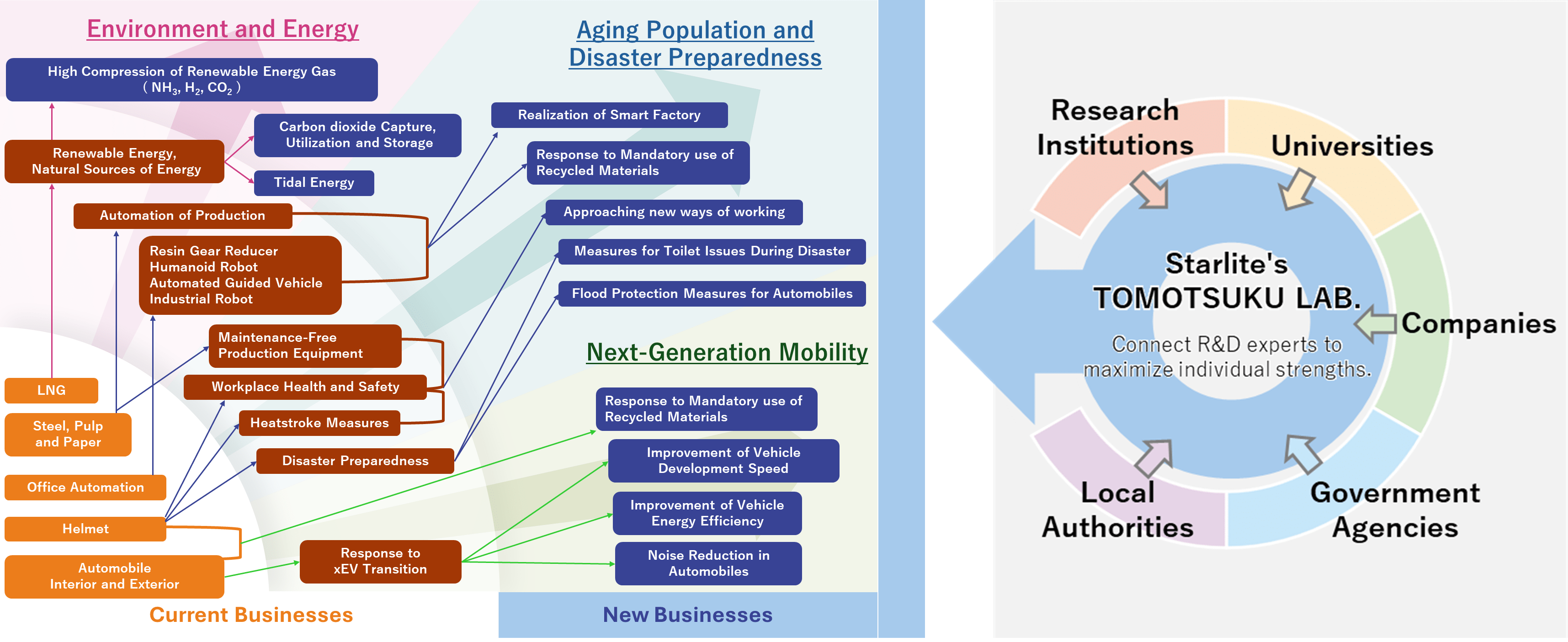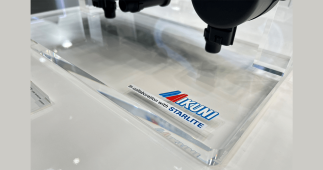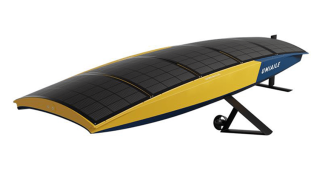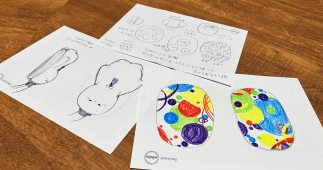
Collaboration
Create new values together with partners.
TOMOTSUKU LAB is a platform for like-minded people to come together to create new values. This is a place where we nurture and support each other by connecting Starlite’s technology, information, and network with the partners we meet here. We are dedicated to creating new values in the areas of environment and energy, low birthrate and aging, disasters preparedness, and next-generation mobility. If you are interested in co-creating value with Starlite, please contact us using the inquiry form.
TOMOTSUKU activities!!
Collaboration Fields

Starlite Technology
Material
Features
CAE
Evaluation
Molding
Material
Polymer Alloying Polymer Alloying
The "polymer alloy technology" that we specialize in is a technology based on super engineering plastics. We are further applying this technology to develop new functional materials.
Bioplastic Bioplastic
We develop new materials based on biomass resins derived from plant-based resources, which have never been seen before. Additionally, we have launched the industry's first biomass helmet, leading sustainable initiatives within the industry.
Composite Materials Composite Materials
By combining various organic and inorganic materials to create polymer composites, heat resistance, mechanical properties, and more.
FRP FRP
By combining fiber materials such as chopped, milled, cross, and nonwoven fabrics with plastic, we create new functional materials that could not be achieved with plastics alone.
Polyurea Polyurea
We have the technology to apply polyurea coatings on-site. This "polyurea coating" provides reinforcement and protection effects, such as impact resistance, and can improve the durability, safety, and maintainability of equipment and machinery.
Recycled Material Recycled Material
We are expanding our original recycling technology into the fields of mobility and helmets.
Shermosetting Resin Thermosetting Resin
Since our establishment, we have been designing the compositions of thermosetting resins such as phenolic and epoxy resins. By leveraging and further applying our experience and expertise, we are developing new functional materials.
Laminated Material Laminated Material
We can create original prepregs by combining our unique varnish and substrate, which are filled with fillers in phenolic and epoxy resins. Furthermore, by applying two-dimensional and three-dimensional lamination techniques to this prepreg, we can design new functional laminated materials with excellent heat resistance, mechanical properties, and tribological characteristics.
Fluororesin Fluororesin
We design tribomaterials by adding fillers to fluororesin (such as PTFE) to enhance its wear resistance. These materials are used in harsh tribological environments, such as dry or poorly lubricated conditions. Recently, we have also developed low thermal expansion materials for the new energy field.
Super Engineering Plastic Super Engineering Plastic
Super engineering plastics are a category of plastic materials that possess extremely high strength, heat resistance, wear resistance, chemical resistance, self-lubrication, and other exceptional properties that can surpass metals. We are developing mechanical components made of super engineering plastics, such as polyetheretherketone (PEEK), including gears, bearings, seals, and more, for various industries.
Engineering Plastic Engineering Plastic
A general term for plastics that can be used to propose a wide range of product designs that take into account not only the mechanical properties of the material, but also suggested uses and processing methods. We are developing mechanical components made of engineering plastics such as polyacetal (POM) and polyamide (PA), including gears, bearings, seals, and more, for various industries.
General- purpose Plastic General-purpose Plastic
A relatively inexpensive plastic that is used in large quantities in miscellaneous goods, home appliances, automobiles, industrial materials, etc. Representative general-purpose plastics include high-density polyethylene (HDPE), low-density polyethylene (LDPE), polypropylene (PP), polyvinyl chloride (PVC), and polystyrene (PS) and others. We use PP to produce the exterior and interior of automobiles.
Features
Self- lubricating Self-lubricating
Through mixing technologies such as filler formulation, we enhance the lubrication properties of plastics. For example, we offer solutions that enable stable operation in production equipment requiring a clean environment, without the use of lubricants.
Electrostatic Control Electrostatic Control
Electrostatic control is a method that allows precise control of the electrical properties of resin materials, ranging from insulation to conductive, by adding fillers with conductive or chargeable properties to various resins.
Tracking Resistance Tracking Resistance
Typically, plastics are insulating, but when dirt such as moisture or salt accumulates and voltage is applied, a potential difference forms on the surface, causing current to flow. This can generate heat, leading to short circuits or ignitions (tracking). Our material formulation and surface treatment technologies allow us to adjust conductivity and combustibility, enabling us to design materials with excellent tracking resistance performance.
Continue Rolling Continue Rolling
To achieve smoother operation using less energy, we proposed a product design that takes advantage of the self-lubricating properties of plastics.
Seal Ring Dynamic / Static Seal Ring
Dynamic / Static Seal Ring We offer the best solutions for sealing rings and bearings used to prevent leaks not only from stationary parts but also from rotating or reciprocating parts. We utilize technology that can reliably prevent leakage even in temperature environments ranging from -250 to 100°C.
Slippery Slippery
We propose products that exhibit the best sliding performance in clean environments where lubricants such as oil are particularly undesirable, that is, under lubricant-free conditions. In addition, for underwater and special gas atmosphere conditions, we develop quick proposals based on our abundant track record.
Friction Friction
We can control friction to maintain an exquisite handling sensation and achieve stable sliding under any temperature conditions.
Heat Mgmt. Heat Management
We provide total solutions for heat management by utilizing our unique material design technologies, such as phenolic resin laminating techniques, and CAE analysis technologies. For example, we propose systems that efficiently utilize limited energy, such as mechanisms for heat insulation and the effective use of excess heat.
Abradable Abradable
We have material design technology that allows us to control the wear properties of materials. For example, an abradable seal using this technology can maintain optimal clearance, enabling it to meet stringent leakage prevention requirements.
Plastic Reducer Design Plastic Reducer Design
Propose designs for compact, lubrication-free, and low-noise plastic reducers for service robots, copiers, housing equipment, transport equipment, and underwater equipment.
Weight Reduction Weight Reduction
By utilizing CAE analysis technology to achieve product designs that minimize waste, we propose swift and optimal solutions for the lightweighting of units and equipment.
Antimicrobial Antimicrobial
Developed a material that effectively imparts antibacterial properties.
CAE
Flow Analysis Flow Analysis During Injection Molding
We can predict the filling and shrinkage behavior of molten resin injected into the mold of an injection molding machine. By understanding factors such as moldability, the location of weld lines, required clamping force, and tendencies for warping and deformation in advance, we can apply these insights to mold designs that improve productivity and product quality. With over 5,000 successful cases, we aim to further improve prediction accuracy based on these accumulated experiences.
Analysis Parameter Optimization Analysis Parameter Optimization
By adjusting settings such as mesh, boundary conditions, and material properties, we can achieve a balance between analysis accuracy and computational efficiency. In particular, we are optimizing parameters in resin flow analysis to minimize the discrepancy between predicted and actual results.
Structural Structural Analysis
This is a technology that simulates the forces, stresses, deformations, and vibrations acting on products and structures, and evaluates the strength and durability of the design. This enables the reduction of development costs and time while ensuring safety for various products, such as automotive exterior parts, gear units, and seal components.
Multiphysics Multiphysics
This is a simulation technology that combines different physical phenomena. For example, by performing structural analysis (stress and deformation) along with thermal analysis (temperature changes) and fluid analysis (flow effects) simultaneously, it enables highly accurate simulations that take interactions into account.
Impact Impact Analysis
This technology simulates the response of products and structures when subjected to instantaneous impact or high loads. In this analysis, detailed calculations over short time intervals are required to accurately simulate nonlinear behaviors such as large deformations, fractures, and plastic deformation of materials. For example, it is applied to predict pedestrian protection performance in automotive exterior parts and impact strength of wiper components in steel production lines.
Fluid Fluid Analysis
It is a technology that simulates the flow of fluids and their impact on the surrounding environment. This analysis calculates the velocity, pressure, and temperature changes of fluids such as air, water, and oil, and it evaluates their impact on products and structures.
Evaluation
Friction & Wear Friction and Wear Evaluation
We are developing a unique friction and wear testing machine that can replicate the operating environments of bearings and gears. It enables evaluations not only under high-temperature and high-load conditions but also under extremely low temperatures and atmospheric gas environments.
Evolved Gas Evolved Gas Analysis
Our in-house specialized analytical department can immediately respond to inquiries such as whether the proposed materials or components emit regulated gases or to identify the cause of contamination during mass production.
Cryogenic Environment Cryogenic Environment Evaluation
Our unique evaluation technology allows us to assess the physical properties of plastic materials in ultra-low temperature environments. By investigating the behavior of materials under these conditions, we contribute to the development of superior materials.
Water Lubrication Water Lubrication Test
Our independently developed evaluation devices enable the assessment of various operating conditions in water-containing environments. By conducting tests in environments that closely simulate actual conditions (such as contact pressure and speed), we propose materials that are optimal for specific applications.
Compositional Compositional Analysis
We conduct composition analysis by combining techniques such as X-ray fluorescence (XRF), infrared spectroscopy (IR), and mass spectrometry (MS). This analysis helps improve material quality by verifying whether the composition matches the design and ensuring that no impurities or foreign substances are present.
Sliding Characteristics Sliding Characteristics Analysis
We observe the surface of the test piece using an electron microscope after the sliding test. Additionally, by analyzing the transfer film on the surface, we conduct a more comprehensive evaluation. Our specialized concierges will help you quickly resolve any issues.
Molding
Mold Mold
We offer a seamless and speedy in-house process from product design to mold design and manufacturing. Our mold design team includes veteran engineers with over 30 years of experience, deeply knowledgeable in resin material characteristics. By utilizing CAE analysis and real-world testing, we deliver reliable product proposals in a short time.
Large Injection Large Injection Molding
At our plants in Hiroshima and Yamaguchi, we design and manufacture large automotive exterior parts with widths comparable to that of a vehicle, meeting high surface quality requirements.
Large Compression Large Compression Molding
We are capable of mass-producing fluoropolymer-based seal rings and bearing products with diameters exceeding 1,000 mm.
Two-color Two-color Molding
We operate one of the world’s largest injection molding machines, with a clamping force of 1,850 tons. This large-scale two-color molding machine enables the integration of soft and hard materials into a single molded part. As a result, it helps reduce assembly steps and enhances the airtightness between different materials.
Molding DX Molding DX
We are advancing the implementation of automatic correction functions (AI) for injection molding conditions, aiming to eliminate product defects in mass production and effectively utilize recycled materials, which are often challenging to utilize due to their unstable moldability.
Sandwich Sandwich Injection Molding
This technology allows the creation of a skin/core structure by combining different. For example, we propose new ways to utilize recycled materials, such as using virgin material for the surface and recycled material for the interior.
Ram Ram Continuous Extrusion Molding
This is a molding technology for long-length products made from ultra-high molecular weight polyethylene (UHMWPE), which has extremely high melt viscosity, and fluoropolymer (PTFE), which has no flowability.
Injection Injection Molding
We have decades of experience in injection molding for mass production with most types of plastic materials. For example, our strength lies in the ability to precisely mold very high-viscosity resin materials, such as PEEK with fillers, and in our capability to design the molds required for such processes.
Compression Compression Molding
We have many years of experience in compression molding and manufacture products made of thermosetting resins and fluororesins. We have been engaged in compression molding for a long time.
Continuous Press Continuous Press Molding
Batch-type press machines, which charge the material in a mold and then repeatedly perform heating and compression molding, have long tact times, but our unique continuous press molding significantly improves mass productivity and makes it possible to mold long, seamless products.
Foaming Foaming Molding
A molding technology that foams molten resin with gas or chemicals to reduce weight and improve impact resistance and heat insulation. It is also effective in improving sink marks caused by thermal shrinkage in thick parts.
Transfer Transfer Molding
In this molding process, we first store the pre-softened material and then rapidly inject it into the mold. This technique is especially useful for highly viscous materials, such as polyetheretherketone (PEEK) and thermoplastic polyimide (TPI).
Spray Spray Painting
It is a coating technology using polyurea resin with high impact resistance. For example, it improves wear resistance on the inner surfaces of metal pipes, strengthens lightweight materials like foam, prevents peeling and crack propagation on walls and concrete surfaces, and extends the lifespan of equipment, all contributing to enhanced safety and maintainability.
Roll Winding Roll Winding Molding
After wrapping the reinforced fiber resin base material around a roll (mandrel), we heat and solidify it to form the product. We use this molding process to produce marine bearings with diameters of over 1m.
Injection Press Injection Press Molding
In this molding technique, the clamping mechanism presses the injected resin. This method can help reduce distortion by relieving residual stress in the mold, and improve transferability, among other benefits.
Insert Insert Injection Molding
This molding technique involves placing an insert in the injection molding mold and injecting plastic over it. This method can lead to reduced assembly labor and improved product strength.




